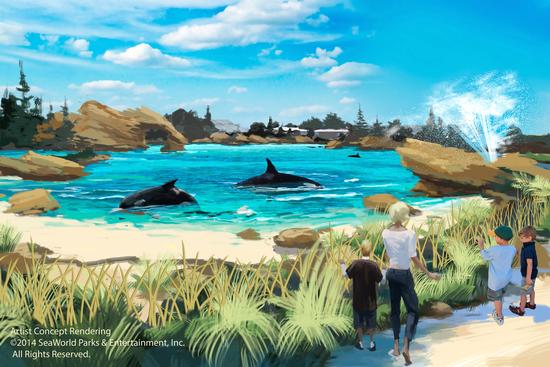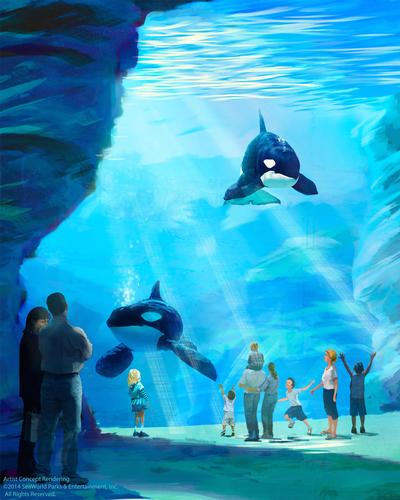
The "Blue World Project" will begin at SeaWorld San Diego, with a planned opening in 2018. According to the park's press release, "With a planned maximum depth of 50 feet, surface area of nearly 1.5 acres and spanning more than 350 feet in length, the new environment will also have views exceeding 40 feet in height, providing guests with the world’s largest underwater viewing experience of killer whales."

“Through up-close and personal encounters, the new environment will transform how visitors experience killer whales,” SeaWorld CEO and President Jim Atchison said in a statement. “Our guests will be able to walk alongside the whales as if they were at the shore, watch them interact at the depths found in the ocean, or a birds-eye view from above.”
This follows a trend among zoos to create larger, more natural-looking environments for their animals, eschewing the basic, utilitarian exhibits of the past. To that end, SeaWorld has assembled an advisory panel of scientists and researchers to oversee the creation of the new habitat, including representatives of the Association of Zoos & Aquariums, the American Humane Association, the Scripps Institution of Oceanography, and the University of California. New orca habitats will follow in Orlando and San Antonio.
* * *
Okay, some analysis: This looks great, but it looks more like something I'd expect to see at a world-class zoo or aquarium, and not necessarily like a theme park attraction.
Which is fine -- despite what some idealistically naive people believe, we need zoos and aquariums to lead research and inspire people to want to protect natural habitats. SeaWorld's long tried to walk a line that connects theme parks with zoos and aquariums. But if SeaWorld's looking to reverse an attendance slide that began in 2010 with the death of trainer Dawn Brancheau and the removal of the orca trainers from the water (not to mention the sale of the parks from their long-time owner Anheuser-Busch following the brewer's takeover by InBev), one ought to note that theme parks draw a lot more people than zoos and aquariums. The only accredited zoo in the country that draws more annual visitors than the SeaWorld parks is Disney's Animal Kingdom, which for years actually promoted itself as "not a zoo."
So I wish SeaWorld well with this project. But if SeaWorld wants to compete with theme parks, and reverse its attendance slide, it's going to need more than better habitat exhibits, even as impressive as this one appears to be.
Previously:
BTW, the 2nd Quarter results were not as "disappointing" as they were skewed. The chain noted that admissions were up (3% in fact from 2Q13), but total revenue was down 1%. It has been posited that the park took the wrong tact following the Blackfish backlash, and offered too many discounts, which brought in the wrong crowd to their parks. They attempted to boost attendance in the wake of the controversy, and ended up with guests that didn't spend money in the parks, making revenues relatively flat year over year.
I agree that the SeaWorld and Animal Kingdom theme parks are not classic zoos and the research should not necessarily be taken seriously, but this doesn't mean they can't have a role to play in conservation. While zoos are very important, they require government funds and donations to survive. The current model isn't sustainable and many zoos had to cutback on operations and some closed.
SeaWorld is in a bad place due to Blackfish, but they aren't even close to closure. I do think they need to add more attractions to be a contender in the theme park marketplace. There is a natural ceiling for these animal-oriented theme parks. The guests seem to age out. SeaWorld attracts a similar guest profile to Legoland. They skew to younger crowds who value education and cute animals.
I do think the huge Orca aquariums will be an innovation that no other zoo or aquarium can tout. It seems like private enterprise can sometimes do bigger things than government sponsored public zoos and aquariums.
While the rock work will create a more naturalistic looking habitat, the real benefit to the whales will be in the diversity of features that will make the habitat dynamic for THEM! I refer to the changes in water depth- from (judging from concept art) a shallow beach area to 50' plunge, and also the (not mentioned in this report) water current system that the whales can swim against.
The huge underwater viewing panel will be astounding- I cannot wait to see it first hand!
I agree with Robert's comment about still needing attractions to draw more crowds though. This expansion is great for the whales and expands something SeaWorld already does well (animal exhibits), I just hope that they continue invest other capitol in new attractions at the same time. This investment does seem to be a result of criticism of the park- and I would like to note that there is nothing SeaWorld can do to appease their strongest critics- so I hope they do not put to much energy in trying. They need to focus on continuing their outstanding care of animals while still offering their guests that support them new experiences!
Annon Mouse- I am unsure if your comment that the research at DAK and SeaWorld should not be taken seriously was typo or not- but I must strongly disagree. Both parks have, and continue to do innovative AND respected research for animals around the world.
I don't know anything about their research, but whatever they are doing, that is not central to what they are actually doing, which is running a theme park and having Shamu, dolphin, and sea lion shows. I do think whatever good they are doing with research, it isn't enough when their practices are questioned with Blackfish. Obviously, they must do more and they need to be more transparent. In addition, be more careful so their trainers are not inadvertently injured.
I also am confused on your comment about zoos... it makes me wonder if I missed some news. Where did you get the idea that zoos' current model isn't sustainable, and which accredited zoo has closed recently? I am not trying to be snarky, I truly am wondering if I missed something.
I DO agree that SeaWorld needs to be more transparent, and I believe they have started doing just that. For example when SWF lost their Polar Bear a few weeks back they were very upfront about it. As far as questions raised by that silly movie... that film did not introduce anything had not already been said. What the park really needs to do is figure out how to get the guillible audiences of that movie to realize that they have been misled and duped by an extremist point of view.
I think this huge investment into the orca habitats is a signal that the park is committed to their mission, and is willing to continue to invest in their signature attractions.
The opponents have proven themselves to be tactless, subjective, and dishonest. Those who have signed onto the Blackfish mission have lost much of their professional reputation because of the totally biased and fame/financial motivations of the documentarians along with the PETA-backed protests that were clearly politically motivated and bordered on blackmail. These opponents obviously don't find Sea World's conservation objectives compelling because it doesn't support their goal to eliminate animal captivity at all cost.
Sea World Parks and Entertainment is certainly not a public zoo, but the research, training, and awareness that they conduct while entertaining and educating their guests is a valuable contribution to the world. The work that they do has gone a long way in helping other zoos maintain their animals and train their staff (primarily Columbus and San Diego Zoos---2 of the most successful zoos in the US). Add the education and inspiration that they provide to their guests through exhibits, shows, and other efforts (like the Sea Rescue TV show), and I'd say their work is far from irrelevant. Just because they make money, and enhance their guest experiences with some thrill rides, doesn't mean they cannot promote a positive message about conservation and environmentalism.
Also, if you think Sea World only skews to the young, you might want to actually take a trip to one of the parks to see the blend of guests for yourself. While, their attractions and shows tend to attract smaller kids, they also attract adults and a large number of senior citizens. I'd say Sea World's demographics are more like EPCOT and attract far more diverse guests than Legoland.
They need to end performances from the whales, and if possible, introduce more enrichments (the water current turbine is a good start - but also more toys, organic interactions etc etc), they need to be WAY more transparent with their education track records, scientific papers, and studies, and invest in more scientists getting actively involved in advancing Orca research on site, at the park - though it seems as everything one can learn from a captive animal has been learnt.
My point being, is there's a LOT of things that Seaworld can do to advance its business while also acting responsibly and ethically towards the public. They don't have to 'shut down' or 'release the whales' (a lot of them wouldn't be good candidates anyway) but they are acting like a petulant child and the instead need to act like an industry leader.
I agree with most people that they should move towards thrill rides and other theme park endeavors, and sanction off their animal counter-parts to be solely educational, scientific, and above all humane.
This article has been archived and is no longer accepting comments.
I personally have no issues with the animals being in captivity. My recommendation to help people forget about Blackfish is to offer free beer in the parks. Alcohol has this interesting ability to cause short term memory loss when consumed in large quantities.